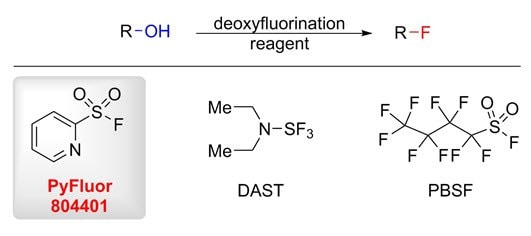Deoxyfluorination with 2-Pyridinesulfonyl Fluoride (PyFluor)

Introduction
The prevalence of organofluorine compounds in industry and drug design necessitates the ability to introduce C–F bonds to molecules. Deoxyfluorination of alcohols is a well-precedented technique for synthesizing aliphatic fluorides. Diethylaminosulfur trifluoride (DAST) has emerged as the most popular deoxyfluorinating reagent for its availability and broad substrate scope.1 However, its use is limited to small-scale preparations because of its tendency to detonate catastrophically at elevated temperatures. In addition, DAST frequently affords elimination byproducts that complicate purification. Perfluoro-1-butanesulfonyl fluoride (PBSF) has also been explored but is likewise poorly selective.2
To overcome selectivity and safety challenges, Sigma-Aldrich is pleased to offer 2-pyridinesulfonyl fluoride (PyFluor, 804401) in collaboration with Professor Abby Doyle. PyFluor chemoselectively fluorinates a diverse scope of alcohols with substantially less elimination side products than DAST or PBSF. In addition, PyFluor does not undergo thermal decomposition and is a low-melting crystalline solid that can be stored at room temperature for over a month with no detectable decomposition. By contrast, DAST must be refrigerated and reacts violently with water. PyFluor’s thermal and chemical stability as well as superior safety profile welcomes various applications and scalability. Together, PyFluor is a premier choice for deoxyfluorination chemistry on a preparatory scale.3

Advantages
- Chemoselective deoxyfluorination with minimal elimination side products, competitive with DAST, PBSF, Deoxo-Fluor, XtalFluor, and Fluolead
- Superior thermal and chemical stability with a greater shelf life than other commercial deoxyfluorination reagents
- Safe and convenient: tolerates air and moisture
Representative Applications
PyFluor is a general deoxyfluorination reagent for primary and secondary alcohols and tolerates basic functionality including phthalimides, heterocycles, and protected or tertiary amines and anilines. PyFluor requires the use of a strong Brønsted base such as 1,8-diazabicyclo-[5.4.0]undec-7-ene (DBU) or 7-methyl-1,5,7-triazabicyclo[4.4.0]dec-5-ene (MTBD). Reactions are typically performed at room temperature in toluene or ethereal solvents.

Producing considerably less elimination byproducts, chemoselective fluorination with PyFluor leads to straightforward purifications and scalability. This and its broad substrate scope indicate the potential for PyFluor applications in late-stage functionalization of bioactive molecules.

Special thanks to Professor Abby Doyle and Matthew Nielsen for contributing this technology spotlight.
Materials
References
To continue reading please sign in or create an account.
Don't Have An Account?